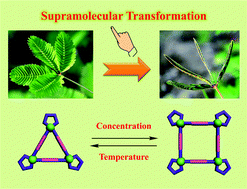Supramolecular transformations within discrete coordination-driven supramolecular architectures
Abstract
In this review, a comprehensive summary of supramolecular transformations within discrete coordination-driven supramolecular architectures, including helices, metallacycles, metallacages, etc., is presented. Recent investigations have demonstrated that coordination-driven self-assembled architectures provide an ideal platform to study supramolecular transformations mainly due to the relatively rigid yet dynamic nature of the coordination bonds. Various stimuli have been extensively employed to trigger the transformation processes of metallosupramolecular architectures, such as solvents, concentration, anions, guests, change in component fractions or chemical compositions, light, and post-modification reactions, which allowed for the formation of new structures with specific properties and functions. Thus, it is believed that supramolecular transformations could serve as another highly efficient approach for generating diverse metallosupramolecular architectures. Classified by the aforementioned various stimuli used to induce the interconversion processes, the emphasis in this review will be on the transformation conditions, structural changes, mechanisms, and the output of specific properties and functions upon induction of structural transformations.


 Please wait while we load your content...
Please wait while we load your content...